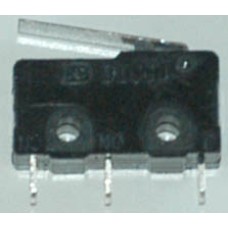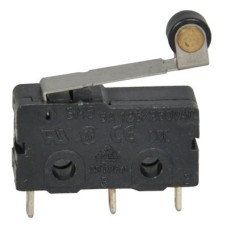Mountain Switch

Overview
These are inexpensive, very small lever switches that can be used to sense the position of an airbrake or flap actuator or to sense that the landing gear is up or down and locked. They can be wired as either normally-open (no current flow when not activated, current flow when activated) or normally-closed (current flow when not activated, no current flow when activated). See dimensional drawing below for wiring instructions. The switch is also labeled near the connectors with "C" for common, "NO" for normally-open, and "NC" for normally-closed. The connectors on the bottom of the switch are "solder lugs" designed for soldering wires to.
Related Pages
- Hamlin - Magnetic reed sensors
Terminology
- NO (Normally Open) - current flow when activated, no current flow when not activated
- NC (Normally Closed) - no current flow when activated, current flow when not activated
- OP: Operating Position
- FP: Free Position
- Pre-Travel: FP - OP
Applications
- Airbrakes Locked
The goal is to have current flow when the airbrakes are not closed and locked (fully forward)- Use a normally closed switch at the forward (airbrakes locked) position
- Landing Gear Down and Locked
The goal is to have current flow when the landing gear is not down and locked.- If the switch is mounted in the gear down and locked position then use a normally closed switch (recommended).
- If the switch is mounted in the gear up position then use a normally open switch.
- Flap Handle (Cruise/Climb)
The goal is to have current flow when the flap handle is in the climb range (flaps at +1 or greater) and no current flow when the flap handle is in the cruise region (flaps at -2, -1, 0).
Note: You may want to use a roller switch riding on a built-up area of the flap control rod to make sure the switch is activated during the full travel of the flap handle in the desired range.- If the switch is mounted in the cruise region of the flap handle's travel (flaps at -2, -1, 0) then use a normally closed switch. (recommended)
- If the switch is mounted in the climb region of the flap handle's travel (flaps at +1 or greater) then use a normally open switch.
Switch Comparison
Magnetic reed sensors have some advantages and some disadvantages when compared with the mechanical lever switches. Note that both sensor types have moving parts - reed switches have small internal mechanical switches which have a finite life - just like mechanical lever switches do.
- Magnetic Reed Switch
- Advantage: Non-contact, no friction
- Disadvantage: A magnetic target (actuator) must be mounted on the item being sensed.
- Mechanical Roller Switch
- Advantage: The switch senses the actual item being sensed so no magnet needs to be mounted on the item being sensed.
- Disadvantage: Mechanical contact is required so there will be some friction in applications where the target is moving relative to the sensor.
Switch-Lever
Switch, LeverThis is an inexpensive, very small lever switch that can be used to sense the position ..
$4.95
Switch-Roller
Switch, Roller LeverThis is an inexpensive, very small switch with roller that can be used to sense ..
$4.95


